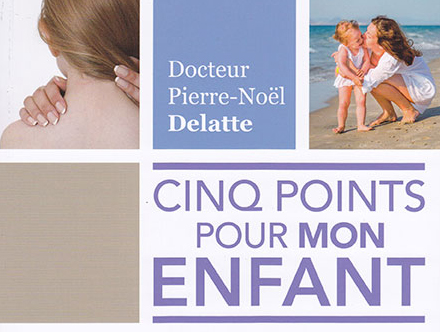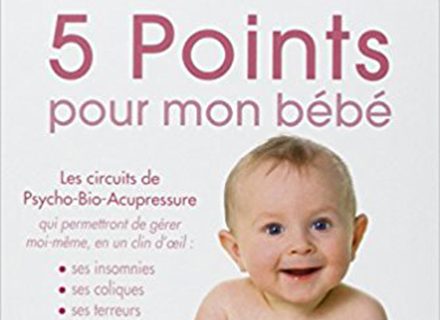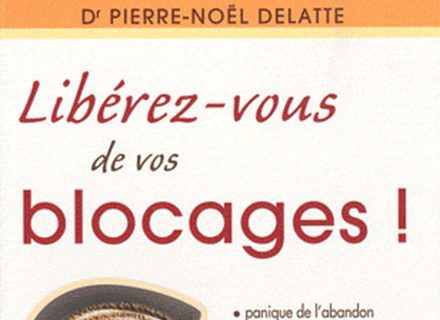
FIVE POINTS FOR MY CHILD
“(…)how do you as parents, utilise PBA to help your children? You will see, it is very simple. (…) The technique is neither complicated nor painful. And thanks to the circuits, you can handle situations that could destabilise them.
(…)These situations that disturb them, they will encounter all their childhood, but with the following circuits, you can help them to not be too perturbed emotionally,(…)you yourself can very quickly have the solution to the majority of problems that can present themselves (…)(the age long principle of oriental medicine is) “it’s better to prevent than cure..,”(…) it is preferable by far to have an attitude of prevention.
When I work in my clinic, many of my patients have understood, they bring me their children as soon as they find themselves confronted with a situation that is potentially disturbing: a change of class, the birth of a little sister, the illness of someone close. They ask me to verify if “nothing has moved.”
And then, we will postpone what I am about to say to the subject of emotional blocks: a child does not relativise. The part of his brain that allows him to relativise, the prefrontal cortex, doesn’t fully develop until 12 years and onward. So, an event which for an adult may seem negligible, can be material, for a child, from which an emotional block can be created, which will follow him for the rest of his life…Moving house for example, if he experiences an overwhelming loss of familiar landmarks, may result in fears of the unknown, a fear to do something new, and even worse, could lead to a chronic instability, once the child has become an adult, (for by fear of again being uprooted he will have a fear to put down roots, to engage or commit himself in his professional life as well as his affective life.) So, if at each time they move house, the parents have the wisdom of prevention, to apply the protocol that I advise in such situations, chances are that the block will not appear.
You who are reading this book, do not wait until your children are unwell.
You can be certain that you can help them. If you are vigilant and preventative, you will have much more chance of avoiding the appearance of emotional blocks that can, in the end, destabilise them for the rest of their lives. This will be in chapter 4: the utilisation of protocols of PBA circuits to manage situations either emotionally difficult, or that can potentially generate blocks.
Thanks to these very simple rules, you will help your children confront life, and become balanced adults. Knowing that, if despite all your efforts, they could not face certain situations, there is still the possibility of appealing to a PBA practitioner.
TEACHING YOUR CHILDREN TO TAKE CHARGE OF THEMSELVES P169
I often alluded, in the preceding pages, to the fact that it is important that your children are able to, in certain circumstances, take charge of themselves with a few circuits of PBA. (…) Thanks to this technique, you can help them handle many situations, (…) you will feel more relaxed, serene and confident, knowing the precious aid that you personally can bring them. However, for a complete picture, the ideal would be that in certain cases your children are capable of doing certain circuits by themselves. This will avoid that certain situations that they will experience don’t become too complicated and degenerate. (…) They can resolve the situation themselves and you will not need to assist: because it is certain you cannot always be with them, behind them, to solve all their difficulties.(…)
Three principal (circuits) to teach them are No. 11, 3 and 8.
No.11, because it permits to regularise and harmonise the functioning of the left and right brain: this develops concentration, (and) learning capacities(…)
No.3, because it permits management of fears, anxiety, even panic, for the situations where children become fearful are well known: it is therefore good for them to know how to do this circuit, as soon as the anxiety mounts.
No.8, because it favourites expression. We will speak of this soon, but it is fundamental to manage nervousness and exams, oral and even written.
Circuit No. 14 will be precious (…)for a child who is starting to show signs of acne,
Circuit 15 can help fight the abusive tendency to feel guilty, but most of all it acts on the tonicity of the bladder and thus permits to fight against bedwetting.(…) A problem that can spoil their life, (…)especially if they have a sleep-over at friends, or participate in a school camp. And so, this problem can often regulate itself easily by the application of circuit 15, at night, at bed-time, plus the 3
You can also explain to them that if they do the 3 when they go to bed, there is a good chance they will avoid having nightmares and night terrors.
Finally, in the case of excessive timidity, the 3 and the 8 (similar to nervousness) can lessen the problem.
You see, it is very simple. Teaching your children (a few) circuits allows them to adapt themselves to many situations, and they will be so proud of themselves for managing to be able to handle things by themselves.
Now it is time to go to the third section of this book (…)(which) concerns the emotional blocks that could effect your children and that the practitioners can work on (…)”
Author Dr. Pierre-Noël Delatte – Éditeur Guy Trédaniel, – PBA used daily for children. Page 56.
A brief translation by Desbina, I apologise in advance for any mistakes.



Add A Comment
You must be logged in to post a comment.